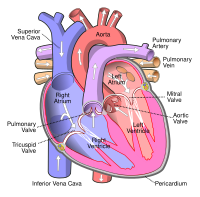
Photo from wikipedia
AIMS The management of congestion is one of the key treatment targets in heart failure. Assessing congestion is, however, difficult. The purpose of this study was to investigate the safety… Click to show full abstract
AIMS The management of congestion is one of the key treatment targets in heart failure. Assessing congestion is, however, difficult. The purpose of this study was to investigate the safety and dynamic response of a novel, passive, inferior vena cava (IVC) sensor in a chronic ovine model. METHODS AND RESULTS A total of 20 sheep divided into three groups were studied in acute and chronic in vivo settings. Group I and Group II included 14 sheep in total with 12 sheep receiving the sensor and two sheep receiving a control device (IVC filter). Group III included an additional six animals for studying responses to volume challenges via infusion of blood and saline solutions. Deployment was 100% successful with all devices implanted; performing as expected with no device-related complications and signals were received at all observations. At similar volume states no significant differences in IVC area normalized to absolute area range were measured (55 ± 17% on day 0 and 62 ± 12% on day 120, p = 0.51). Chronically, the sensors were completely integrated with a thin, reendothelialized neointima with no loss of sensitivity to infused volume. Normalized IVC area changed significantly from 25 ± 17% to 43 ± 11% (p = 0.007) with 300 ml infused. In contrast, right atrial pressure required 1200 ml of infused volume prior to a statistically significant change from 3.1 ± 2.6 mmHg to 7.5 ± 2.0 mmHg (p = 0.02). CONCLUSION In conclusion, IVC area can be measured remotely in real-time using a safe, accurate, wireless, and chronic implantable sensor promising to detect congestion with higher sensitivity than filling pressures.
Journal Title: European journal of heart failure
Year Published: 2023
Link to full text (if available)
Share on Social Media: Sign Up to like & get
recommendations!